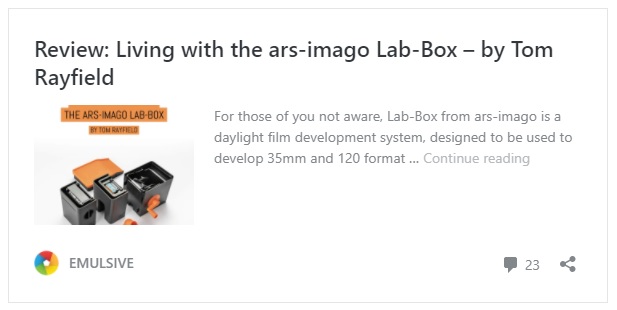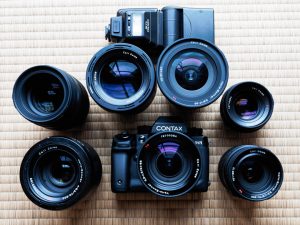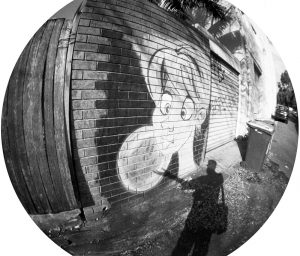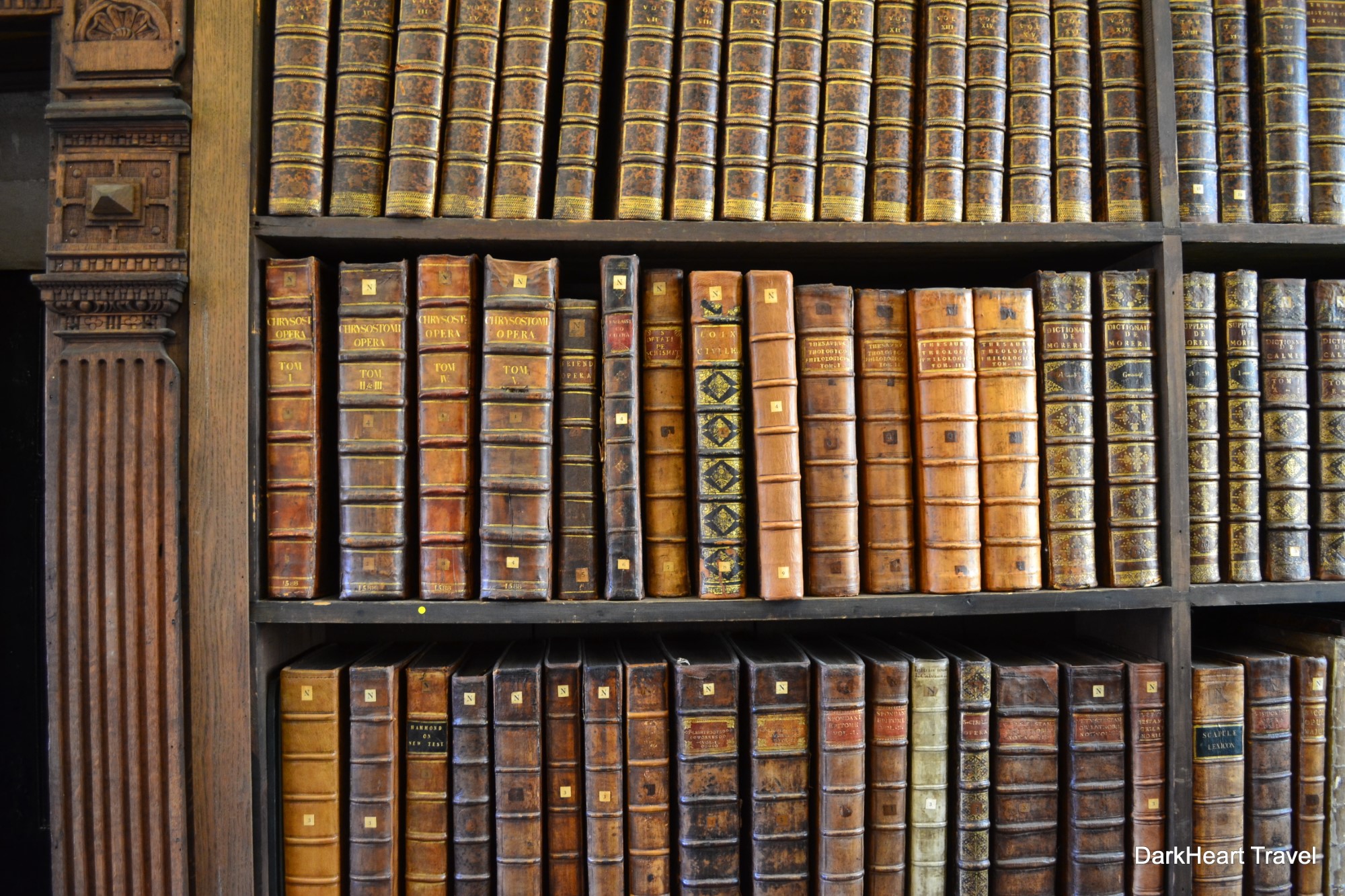The problem with doing these Recommended Reading posts every other week, is that if something good is posted shortly after my previous post, then it takes almost a whole two weeks before I get around to it, but I figure if it’s something I missed, then perhaps you missed it too, and this week, my featured post is an excellent look at the ars-image Lab-Box by Tom Rayfield at EMULSIVE.
 Products like the ars-imago Lab-Box fill a void created when all-in-one daylight developing products like the Leitz/AGFA Rodinax were discontinued. These products were meant to simplify developing by allowing you to insert your film into a box filled with development chemicals, connect the leader to some type of ‘feeder tongue’, and turn a crank. Of course, it’s more complicated than that, but the idea was to eliminate the need of using separate development tanks and loading film in complete darkness.
Products like the ars-imago Lab-Box fill a void created when all-in-one daylight developing products like the Leitz/AGFA Rodinax were discontinued. These products were meant to simplify developing by allowing you to insert your film into a box filled with development chemicals, connect the leader to some type of ‘feeder tongue’, and turn a crank. Of course, it’s more complicated than that, but the idea was to eliminate the need of using separate development tanks and loading film in complete darkness.
The Lab-Box is modular, so it supports both 35mm and roll film formats (via a separate purchase). It is designed to be simple to use, but as Tom mentions in his review, there are some pitfalls which can be avoided with a thorough review of the manual. For as easy as the Lab-Box is, it’s biggest con is that it can only do one roll of film at a time, so if you have a backlog of film to develop, getting through multiple rolls can take a while.
Also, at a cost of $179 (with one modular back) plus all the development chemicals, and other parts needed to fully develop film, it’s not exactly a cheap option for someone wanting to try film for the first time.
If you are willing to spend the money though, and you’re good at following instructions, and only ever need to do one or two rolls at a time, it seems like a pretty cool product.
Here are more great posts from some of my favorite sites:
In my last Recommended Reading, I debuted a blogger that’s new to me whom I incorrectly referred to as Dan Curry. Whoops, sorry about that Dan CUNY! As penance, I am featuring yet another of Dan’s excellent reviews, this time of the Minolta Autocord CdS. Minolta made a huge variety of TLRs in the 50s and 60s, some metered and some not. The CdS was one of the later ones and most directly compares to the very popular Yashica-Mat 124G. But where the Yashicas often go for very high prices, Minoltas, who I would argue are better built, more often slip under the radar. Check out Dan’s review and maybe another Autocord is right for you!
Well, now this is strange. For the first time ever, I am recommending two reviews by the same person, but from two different sites. Once again, Dan Cuny appears here, but with a review of the KW Reflex Box that appeared on 35mmc. This was an interesting read for me, not only because this is an interesting SLR box camera, but I actually have one of these in the “review queue”. My issue with mine, is that I need to get the mirror replaced before I can shoot it, and this article just might be the catalyst that gets me to do it. As he has done with the two other reviews I’ve recommended, Dan does an excellent job of covering the camera’s use and some of it’s virtues, light leaks and all!
If your only experience with instant film is through the Fuji Instax system, or the new(ish) Polaroid Originals line, it might surprise you that at one time there were professional instant film cameras with rangefinder or reflex viewfinders and top of the line interchangeable lenses. This week, Alex Luyckx takes a look at one such camera, the Polaroid 600 SE which is loosely based on the also pro Mamiya Universal. This big and heavy black camera uses peel apart pack film, which is no longer made, so reviews like this one are a last ditch to inform people how these once popular cameras work. As always, Alex does a great job not only of discussing the camera, but showing off his wonderful photography skills!

I’ve had a thing for Contax SLRs for quite some time and although the prices on them are a bit higher than other SLR systems, some models like the RX, AX, and RTS III are compelling options. One day while browsing the big auction site for deals, I found a bunch of fairly inexpensive Contax SLRs from their N-series. Thinking I had found a discount entry into Contax SLRs, I learned that although the N-series are newer cameras, they use an entirely different Contax N-mount than the shared Contax/Yashica mount of earlier Contax SLRs. Adding to the fact that Contax N-series cameras almost never come with lenses, I quickly lost interest as I don’t feel like chasing down an uncommon lens mount just to use with one camera.
So this week, I was especially interested to read this excellent review by Eric Charles Jones at casualphotophile of the Contax N1, a cleanly designed and modern SLR with automatic focus and all the shooting modes you could ever want. By the end of the review, Eric has me sold on getting one, except where he suggests that the N1 (and lens) are priced lower than pro-level Canon and Nikon cameras, which, unless Eric has access to a different auction site than I do, or only considers a Nikon F6 with Nikkor 50mm f/1.2 lens to be a pro camera, I don’t know that an N1 and lens will be in my budget any time soon.
I’m not in the habit of naming my cameras, but I’ll admit, this week’s post by Alyssa Chiarello of a Canon FTb QL called “Tina” because of all of it’s patina is quite clever. As usual, Aly does an excellent job of walking through the camera’s use while also showing some excellent results she got from hers, along with a short Youtube video. What makes this review really interesting is that the camera seems to be making the rounds of camera review sites, first appearing on Alex Luyckx’s site, then Bill Smith from the Classic Camera Revival Podcast, and now to her. I’m starting to think I should ask Aly to send me this camera, so it can be reviewed by yet another blog!
Apparently the first week of October was “Holga Week” in which you’re supposed to go out and shoot Holgas. I not only don’t own any Holgas, but even if I did, I didn’t know about the occasion, but apparently Peggy Marsh did as she chose to celebrate by shooting a…Diana. I guess that’s close enough as both Dianas and Holgas are well known for their plasticky, lo-fi qualities. This style of photography isn’t for everyone, but if it’s something you’re interested in, Peggy’s results with the cheap Diana are pretty good.
I generally avoid articles about “new film cameras” that seem to be popping up with regularity on crowdfunding sites. Anything new in the film segment either tends to be some crazy multi format, interchangeable lens mount Kickstarter project that you know will never see the light of day, or some cheap lo-fi plastic camera meant to excite a younger generation of film enthusiasts. So the recent announcement of the all plastic Dubblefilm Show really didn’t do much for me. And it still doesn’t, but that doesn’t mean there can’t be good articles about it. This week Alan Duncan from Canny Cameras follows up an earlier announcement of the Dubblefilm Show with some sample images and feedback from other users. At the end, Alan rightfully points out that even if this camera isn’t for you, at the very least, it suggests an increase interest in film photography, which is never a bad thing.
Two weeks ago, I featured a fantastic post by Sroyon Mukherjee showing some really wild pinhole cameras made out of everything from a soda can to a nut, and at the end of that article, he alluded to a follow up post that goes over making your own pinhole camera and this week, I am happy to see that Sroyon followed through on his promise with this excellent article covering how it’s done. You can make a pinhole camera out of something as simple as a left over Amazon delivery box. As long as it’s light tight and you make the pinhole the right size, you can get some pretty cool images out of it. This post is very detailed without going too much into the technical side of things, and is worth a read, even if you have no interest in ever making your own pinhole camera.
 Some people in the film community cringe whenever the word “Lomography” is mentioned, but if you look past the number of low quality and cheap cameras that the movement champions, there actually are a few cool Lomography cameras. This week, Theo from photothinking takes a look at one of those cameras, the Lomography Fisheye 2, a simple fixed focus camera with a 10mm fixed aperture f/8 glass lens that gives a 170 degree field of view. Using the Fisheye camera is quite a bit of fun, and a heck of a lot cheaper than using a professional fisheye lens like the Nikkor 8mm. You can pick one of these up new for $55 from Lomography’s website, or if you are patient, for much cheaper on eBay. It’s not a camera I would use often, but for when you do, it delivers results you can’t get any other way at that price point.
Some people in the film community cringe whenever the word “Lomography” is mentioned, but if you look past the number of low quality and cheap cameras that the movement champions, there actually are a few cool Lomography cameras. This week, Theo from photothinking takes a look at one of those cameras, the Lomography Fisheye 2, a simple fixed focus camera with a 10mm fixed aperture f/8 glass lens that gives a 170 degree field of view. Using the Fisheye camera is quite a bit of fun, and a heck of a lot cheaper than using a professional fisheye lens like the Nikkor 8mm. You can pick one of these up new for $55 from Lomography’s website, or if you are patient, for much cheaper on eBay. It’s not a camera I would use often, but for when you do, it delivers results you can’t get any other way at that price point.
This week, Jim Grey posts another in his “Thinning the Herd” series in which he looks back on cameras in his collection and shoots them one more time in an effort to decide if he wants to keep the camera or not. This idea of thinning herds is something I desperately need to do as my collection is at a breaking point, but for now, I can thin my herd with a camera that Jim and I both have, the Certo Super Sport Dolly. This compact and well built 1930s folding camera has been a favorite of mine for quite some time, so it’s no surprise to read that Jim was fond of it too. It didn’t deliver the most technically perfect images, but he seems to be have been smitten by the same things that appealed to me. Was this enough for him to keep or thin? You gotta read Jim’s article for that!
If a review could ever be summed up in it’s title, this week’s post by James Tocchio of casualphotophile perfectly sums up the Pentax 67 when he says, “it’s a big camera”. Beyond it’s size though, James takes a pretty thorough look at this monster of a medium format SLR. It does not appear to be a camera for everyone though as James describes it as “slow to use, hard to hold, and a bit clumsy” but for the right person, under the right circumstances, it’s a wonderful tool. Along with a bit of history, some tips on it’s use and of course some excellent sample photographs, is a Pentax 67 in your future?
I was right about to publish this list when I noticed Peggy Marsh snuck in another review right before the deadline. This time it’s the Petri V6 II, a hulking tank of an SLR with their annoyingly unique lens mount. Petri SLRs aren’t known for their reliability, but thankfully, this $10 (I’m too lazy to look up the ASCII code for the British pound symbol) pickup eschews the stereotype and delivered fantastic results. Peggy is the ultimate camera bargain hunter and she just may have found the ultimate camera bargain. She had a few nitpicks about the camera, but nothing that prevented her from really enjoying it. What is your best $10 find?
If you were one of those kids that always took apart your toys to see how they work, then this week’s post by Bob Janes at 35mmc is right up your alley. Bob takes apart an old rangefinder camera (actually a Canonet 19) and reveals a bit about how these cameras work. Perhaps the most interesting thing for those new to film cameras, is in how a rangefinder works. Using a clever arrangement of a half transparent piece of glass called a beamsplitter and mirrors, a double image is created that is coupled to the focus distance of the lens. The article doesn’t go full onto how to take apart or repair a camera, but does do a good job of explaining the basics of how they work. If you’ve never seen the inside of a film camera, this is something you’ll likely find interesting.
As I get older, so do other people, and something that happens when people get older, is that they die, so as people continue to die, there’s going to be more and more people who pass away that I can relate to.
This week, one of the greatest guitar players of my generation, Eddie Van Halen, guitarist from Van Halen passed away at the age of 65 from cancer. Whether you were a fan of Van Halen or hard rock music in general, I would be willing to bet almost everyone has at least once heard something that Eddie played as even beyond Van Halen, he did the guitar solo in Michael Jackson’s “Beat It” and has worked with other bands and musicians like Kiss, Brian May from Queen, and Roger Waters from Pink Floyd.
The video below is a tribute by none other than Howard Stern who talks a bit about how Eddie influenced him, but also features writer/producer/guitarist Steve Nowicki who demonstrates some of Eddie Van Halen’s techniques in the studio. I’ve never had the pleasure of seeing Van Halen live, but I am very familiar with his music and seeing how some of the sounds he made with his guitar is impressive.
Rest in Peace, Eddie.


